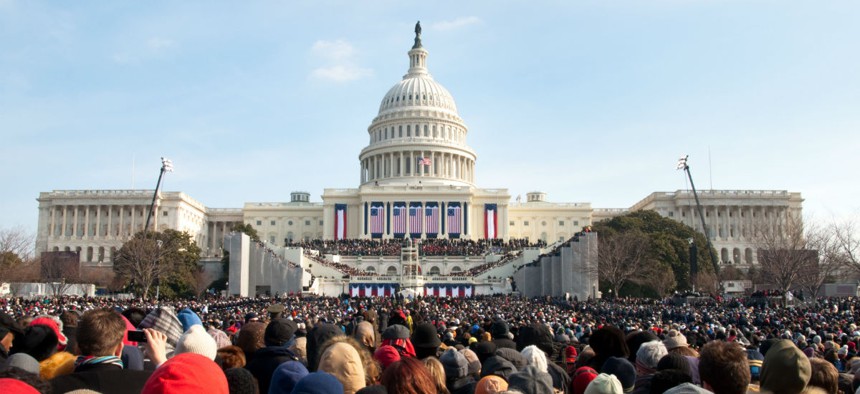
A crowd gathers for President Obama's 2009 inauguration. The transition from George W. Bush to Obama is regarded as one of the smoothest in recent history. Ryan Rodrick Beiler / Shutterstock.com
How One Group is Trying to Prevent Procrastination on Presidential Transition Planning
"Transitions are big, complicated and dangerous," said Max Stier, president and CEO of the Partnership for Public Service, which is forming a resource center on the process.
Exactly one year before the next inauguration, a major good-government group on Wednesday announced the formation of a unique and permanent resource center on presidential transitions. The announcement comes as a surfeit of well-financed candidates creates more than the usual uncertainty about eventual nominees.
The nonprofit Partnership for Public Service, backed by a roster of marquee-name veterans of past transitions, announced the new center at a panel discussion while releasing a 200-page “Presidential Transition Guide” and website with more than 150 reference documents from past transitions.
“Transitions are big, complicated and dangerous,” said Max Stier, president and CEO of the partnership. “There is an expectation that the nation’s newly elected president will hit the ground running, but the transition of power and knowledge from one president to another has traditionally been rushed and chaotic, resulting in delays in filling key jobs, policy blunders and management missteps. A lack of thorough preparation could put the nation in jeopardy and seriously impede the progress of a new administration.”
The group also released new data showing that past transitions have left high-level jobs including sensitive national security posts vacant for months. Historically, less than 30 percent of a president’s top leadership positions are filled by the August congressional recess, the partnership found. Within an average agency, as many as 50 days pass between the naming of the secretary and the nomination of a deputy.
Transitions require candidates, presidential staffs and agencies to work across partisan lines in the heat of competitive and unresolved electoral battles, panelists noted. Stier cited the 2012 readiness effort by Republican Mitt Romney as the best model.
“There has always been an attitude of cooperation in transitions in that we’re all Americans,” said Thomas “Mack” McLarty, former chief of staff to President Clinton. “But after 9/11, the world changed” in that threats to homeland security took on bipartisan urgency. Also, since McLarty’s team took office back in 1993, the information technology revolution has produced “a plethora of information” available to incoming administrations, he added. Campaigns remain somewhat reluctant to be seen too far in advance to be “measuring the drapes” in the Oval Office.
Joshua Bolten, an Office of Management and Budget veteran who was chief of staff to President George W. Bush, said planning for the 2008 transition began about a year before President Obama’s inauguration because Bush wanted the “best and most effective transition in the country’s history.” The 2009 changeover was the first at a time “when the country was under threat,” Bolten added, recounting good cooperation with Obama team leader John Podesta and intentional overlap of homeland security officials on Inauguration Day as they monitored a threatened attack on the ceremony that never materialized.
Bolten also stressed the nonpartisan nature of the Office of Management and Budget staff. Eighty percent of OMB employees are are career employees, who, though willing to switch agendas, can tell the incoming leaders, “Here’s what you need to know” about the bulk of issues that are non-ideological, he said.
The center and the guide provide advice on how to set up and execute a transition, work with the outgoing administration to encourage a smooth transfer of power, share management recommendations for the new administration to address government’s talent and operational challenges, engage Congress to promote presidential transition reforms and prepare new political appointees to lead effectively, the Partnership said.
Stier noted that the 2017 transition will differ because the 2010 Pre-Election Presidential Transition law more than doubles the time in which transition teams receive federal support, from 77 days to summertime before the party conventions.
Other groups active on the transition include the National Academy of Public Administration, the American Society for Public Administration, The White House Transition Project, the Miller Center of Public Affairs at the University of Virginia and No Labels.
Agencies the center is already working with include the FBI, the General Services Administration, the Office of Government Ethics, the National Archives and Records Administration, the Defense Department and the Office of Presidential Personnel.
Also on Wednesday, the six members of the Center for Presidential Transition’s advisory board co-signed an open letter to all major-party presidential candidates urging those still in the race by mid-March to appoint a transition chief and set up a staff to be active before the summer.
The bipartisan group of advisers includes Bolten and McLarty as well as Clay Johnson, former executive director of the Bush-Cheney Presidential Transition; Ted Kaufman, former senator and adviser to the Obama-Biden Transition Project; Michael Leavitt, former governor of Utah and former chairman of the Romney Readiness Project; and Donna Shalala, former Health and Human Services secretary under Bill Clinton.
“Assuming the reins of power of the most important government in the world is complicated and cannot be left to chance,” they wrote. “The presidential candidates must not wait for the 77 days after the November election or even the close of the party nominating conventions this summer to begin getting ready to run our nation’s government. While the candidates need to focus on campaigning and winning primaries and caucuses, they must simultaneously begin laying the groundwork for a disciplined, well-organized transfer of power.”
The Partnership stressed that the next president will be thrown in charge of a 4 million-person organization with an annual budget of $3.7 trillion, and will confront an array of foreign and domestic challenges while simultaneously filling 4,000 key leadership positions. “The 77 days between the election and the inauguration are not enough time for an incoming administration to identify and vet their top management team or get up to speed on the complex policy and management issues they’ll face,” Stier said. “The result has been that every administration has started slowly and behind, negatively impacting policymaking and diminishing the capabilities of our government.”
The partnership’s presidential transition work is funded by the Boston Consulting Group, Accenture, the Ford Foundation, the IBM Center for the Business of Government, McKinsey & Co. and the Rockefeller Brothers Fund.
(Image via Ryan Rodrick Beiler / Shutterstock.com)







